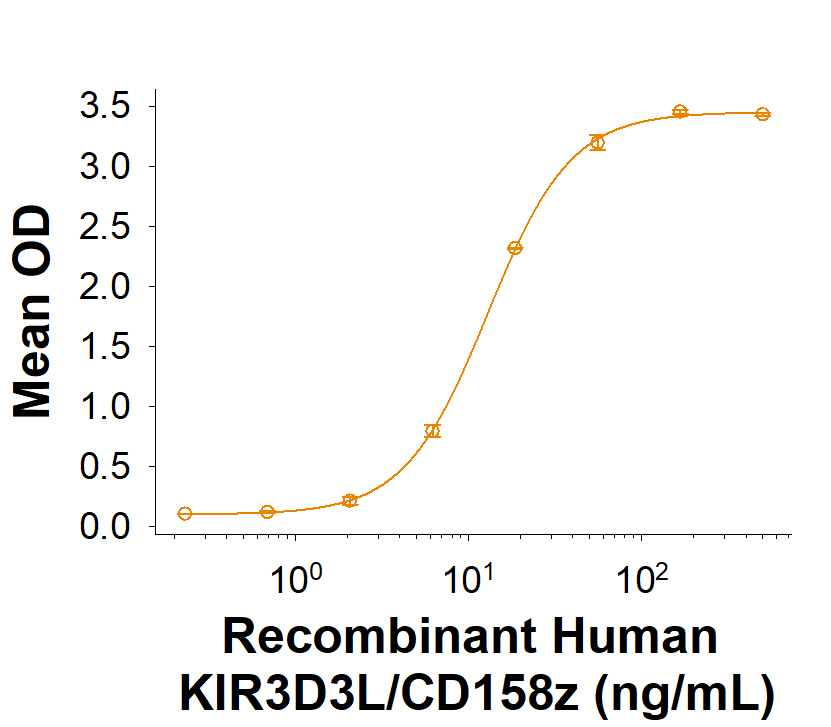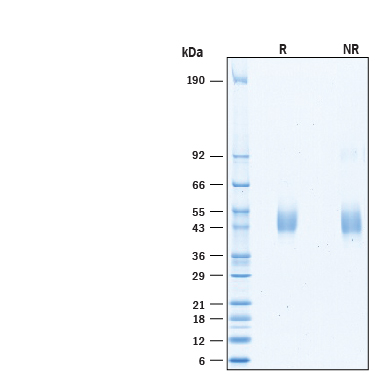Recombinant Human KIR3DL3/CD158z His-tag Protein, CF
Recombinant Human KIR3DL3/CD158z His-tag Protein, CF Summary
Product Specifications
Gln26-Leu322, with a C-terminal 6-His tag
Analysis
Gln26, deduced from Asp27 upon deblocking
Product Datasheets
Carrier Free
CF stands for Carrier Free (CF). We typically add Bovine Serum Albumin (BSA) as a carrier protein to our recombinant proteins. Adding a carrier protein enhances protein stability, increases shelf-life, and allows the recombinant protein to be stored at a more dilute concentration. The carrier free version does not contain BSA.
In general, we advise purchasing the recombinant protein with BSA for use in cell or tissue culture, or as an ELISA standard. In contrast, the carrier free protein is recommended for applications, in which the presence of BSA could interfere.
10454-KR
| Formulation | Lyophilized from a 0.2 μm filtered solution in PBS. |
| Reconstitution | Reconstitute at 200 μg/mL in PBS. |
| Shipping | The product is shipped at ambient temperature. Upon receipt, store it immediately at the temperature recommended below. |
| Stability & Storage: | Use a manual defrost freezer and avoid repeated freeze-thaw cycles.
|
Scientific Data
 View Larger
View Larger
When Biotinylated Recombinant Human B7-H7/HHLA2 Fc Chimera is present at 0.5 μg/mL, the concentration of Recombinant Human KIR3D3L/CD158z His-tag that produces 50% of the optimal binding response is found to be approximately 7.5-45 ng/mL.
 View Larger
View Larger
2 µg/lane of Recombinant Human KIR3DL3/CD158z (Catalog # 10454-KR ) was resolved by SDS-PAGE under reducing (R) and non-reducing (NR) conditions and visualized by Coomassie® Blue staining, showing bands at 42-47 kDa.
Reconstitution Calculator
Background: KIR3DL3/CD158z
KIR3DL3 (also known as CD158z, KIR3DL7, KIR44, or KIRC1) is a type I transmembrane glycoprotein that belongs to the killer cell Ig-like receptor (KIR) family. KIRs are expressed on CD56dim NK cells and T cell subsets where they regulate effector functions in the innate immune system (1 - 4). KIRs are named for the number of Ig-like domains (2D or 3D) in the extracellular domain (ECD), and whether they have long or short (L, S) cytoplasmic tails. Human KIR3DL3 cDNA encodes a 410 amino acid (aa) polypeptide precursor with a 25 aa signal peptide, a 297 aa extracellular domain (ECD) with 3 Ig-like domains (3D), a 21 aa transmembrane domain, and a 67 aa cytoplasmic domain (long). Within ECD human KIR3DL3 shares 47% and 44% aa sequence identity with mouse and rat KIR3DL3, respectively. KIR3DL3 is ubiquitously present in every individual across diverse populations, however little is known about specific functions (5). The limited knowledge of KIR3DL3 expression does suggest involvement in reproduction, likely during placentation (4). KIR3DL3 likely encodes an NK cell inhibitory receptor (6). Recent studies have shown that KIR3DL3 binding and function require both receptor aggregation and inhibitory signal attenuation (7).
- Colonna, M. and J. Samaridis (1995) Science 268:405.
- Lanier, L. L. (2005) Annu. Rev. Immunol. 23:225.
- Uhrberg, M. et al. (1997) Immunity 7:753.
- Trundley, A. E. et al. (2006) Immunogenetics 57:904.
- Hollenbach, J. A. et al. (2012) Immunogenetics 64:719.
- Torkar, M. et al. (1998) Eur. J. Immunol. 28:3959.
- Leaton, L. A. et al. (2019) Front. Immunol. 10:24.
FAQs
No product specific FAQs exist for this product, however you may
View all Proteins and Enzyme FAQsReviews for Recombinant Human KIR3DL3/CD158z His-tag Protein, CF
There are currently no reviews for this product. Be the first to review Recombinant Human KIR3DL3/CD158z His-tag Protein, CF and earn rewards!
Have you used Recombinant Human KIR3DL3/CD158z His-tag Protein, CF?
Submit a review and receive an Amazon gift card.
$25/€18/£15/$25CAN/¥75 Yuan/¥2500 Yen for a review with an image
$10/€7/£6/$10 CAD/¥70 Yuan/¥1110 Yen for a review without an image
